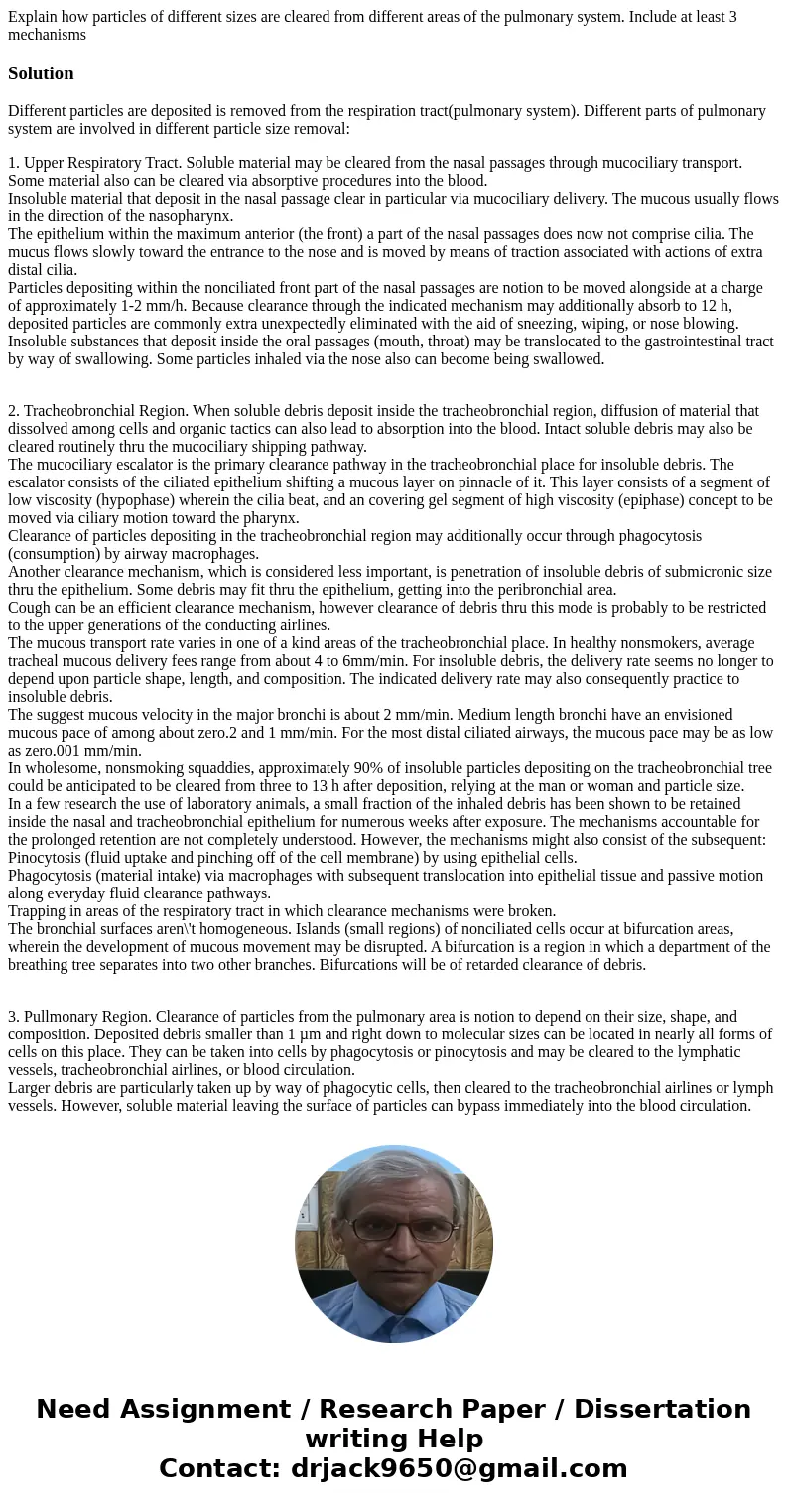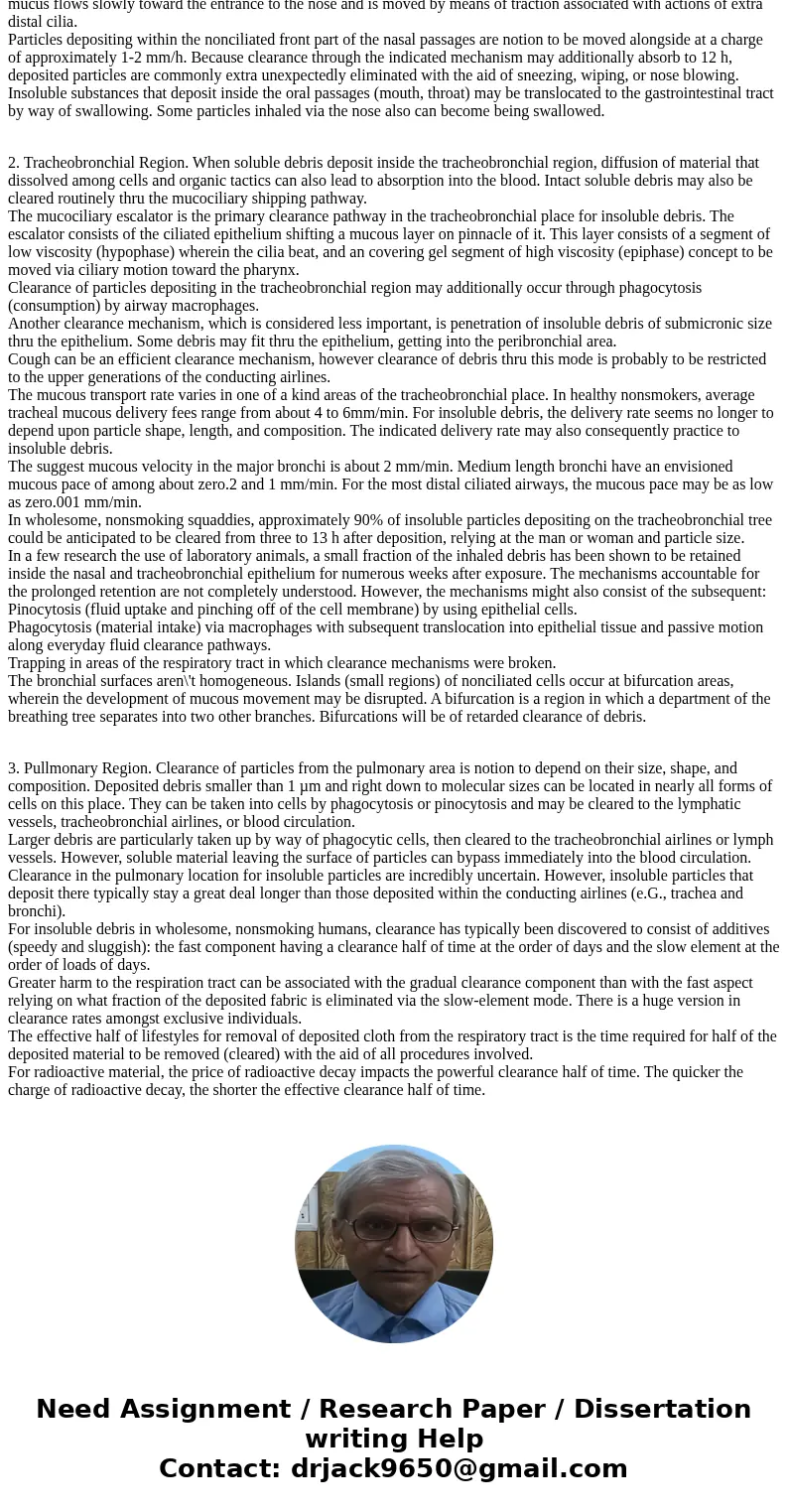Explain how particles of different sizes are cleared from di
Solution
Different particles are deposited is removed from the respiration tract(pulmonary system). Different parts of pulmonary system are involved in different particle size removal:
1. Upper Respiratory Tract. Soluble material may be cleared from the nasal passages through mucociliary transport. Some material also can be cleared via absorptive procedures into the blood.
Insoluble material that deposit in the nasal passage clear in particular via mucociliary delivery. The mucous usually flows in the direction of the nasopharynx.
The epithelium within the maximum anterior (the front) a part of the nasal passages does now not comprise cilia. The mucus flows slowly toward the entrance to the nose and is moved by means of traction associated with actions of extra distal cilia.
Particles depositing within the nonciliated front part of the nasal passages are notion to be moved alongside at a charge of approximately 1-2 mm/h. Because clearance through the indicated mechanism may additionally absorb to 12 h, deposited particles are commonly extra unexpectedly eliminated with the aid of sneezing, wiping, or nose blowing.
Insoluble substances that deposit inside the oral passages (mouth, throat) may be translocated to the gastrointestinal tract by way of swallowing. Some particles inhaled via the nose also can become being swallowed.
2. Tracheobronchial Region. When soluble debris deposit inside the tracheobronchial region, diffusion of material that dissolved among cells and organic tactics can also lead to absorption into the blood. Intact soluble debris may also be cleared routinely thru the mucociliary shipping pathway.
The mucociliary escalator is the primary clearance pathway in the tracheobronchial place for insoluble debris. The escalator consists of the ciliated epithelium shifting a mucous layer on pinnacle of it. This layer consists of a segment of low viscosity (hypophase) wherein the cilia beat, and an covering gel segment of high viscosity (epiphase) concept to be moved via ciliary motion toward the pharynx.
Clearance of particles depositing in the tracheobronchial region may additionally occur through phagocytosis (consumption) by airway macrophages.
Another clearance mechanism, which is considered less important, is penetration of insoluble debris of submicronic size thru the epithelium. Some debris may fit thru the epithelium, getting into the peribronchial area.
Cough can be an efficient clearance mechanism, however clearance of debris thru this mode is probably to be restricted to the upper generations of the conducting airlines.
The mucous transport rate varies in one of a kind areas of the tracheobronchial place. In healthy nonsmokers, average tracheal mucous delivery fees range from about 4 to 6mm/min. For insoluble debris, the delivery rate seems no longer to depend upon particle shape, length, and composition. The indicated delivery rate may also consequently practice to insoluble debris.
The suggest mucous velocity in the major bronchi is about 2 mm/min. Medium length bronchi have an envisioned mucous pace of among about zero.2 and 1 mm/min. For the most distal ciliated airways, the mucous pace may be as low as zero.001 mm/min.
In wholesome, nonsmoking squaddies, approximately 90% of insoluble particles depositing on the tracheobronchial tree could be anticipated to be cleared from three to 13 h after deposition, relying at the man or woman and particle size.
In a few research the use of laboratory animals, a small fraction of the inhaled debris has been shown to be retained inside the nasal and tracheobronchial epithelium for numerous weeks after exposure. The mechanisms accountable for the prolonged retention are not completely understood. However, the mechanisms might also consist of the subsequent:
Pinocytosis (fluid uptake and pinching off of the cell membrane) by using epithelial cells.
Phagocytosis (material intake) via macrophages with subsequent translocation into epithelial tissue and passive motion along everyday fluid clearance pathways.
Trapping in areas of the respiratory tract in which clearance mechanisms were broken.
The bronchial surfaces aren\'t homogeneous. Islands (small regions) of nonciliated cells occur at bifurcation areas, wherein the development of mucous movement may be disrupted. A bifurcation is a region in which a department of the breathing tree separates into two other branches. Bifurcations will be of retarded clearance of debris.
3. Pullmonary Region. Clearance of particles from the pulmonary area is notion to depend on their size, shape, and composition. Deposited debris smaller than 1 µm and right down to molecular sizes can be located in nearly all forms of cells on this place. They can be taken into cells by phagocytosis or pinocytosis and may be cleared to the lymphatic vessels, tracheobronchial airlines, or blood circulation.
Larger debris are particularly taken up by way of phagocytic cells, then cleared to the tracheobronchial airlines or lymph vessels. However, soluble material leaving the surface of particles can bypass immediately into the blood circulation.
Clearance in the pulmonary location for insoluble particles are incredibly uncertain. However, insoluble particles that deposit there typically stay a great deal longer than those deposited within the conducting airlines (e.G., trachea and bronchi).
For insoluble debris in wholesome, nonsmoking humans, clearance has typically been discovered to consist of additives (speedy and sluggish): the fast component having a clearance half of time at the order of days and the slow element at the order of loads of days.
Greater harm to the respiration tract can be associated with the gradual clearance component than with the fast aspect relying on what fraction of the deposited fabric is eliminated via the slow-element mode. There is a huge version in clearance rates amongst exclusive individuals.
The effective half of lifestyles for removal of deposited cloth from the respiratory tract is the time required for half of the deposited material to be removed (cleared) with the aid of all procedures involved.
For radioactive material, the price of radioactive decay impacts the powerful clearance half of time. The quicker the charge of radioactive decay, the shorter the effective clearance half of time.


 Homework Sourse
Homework Sourse